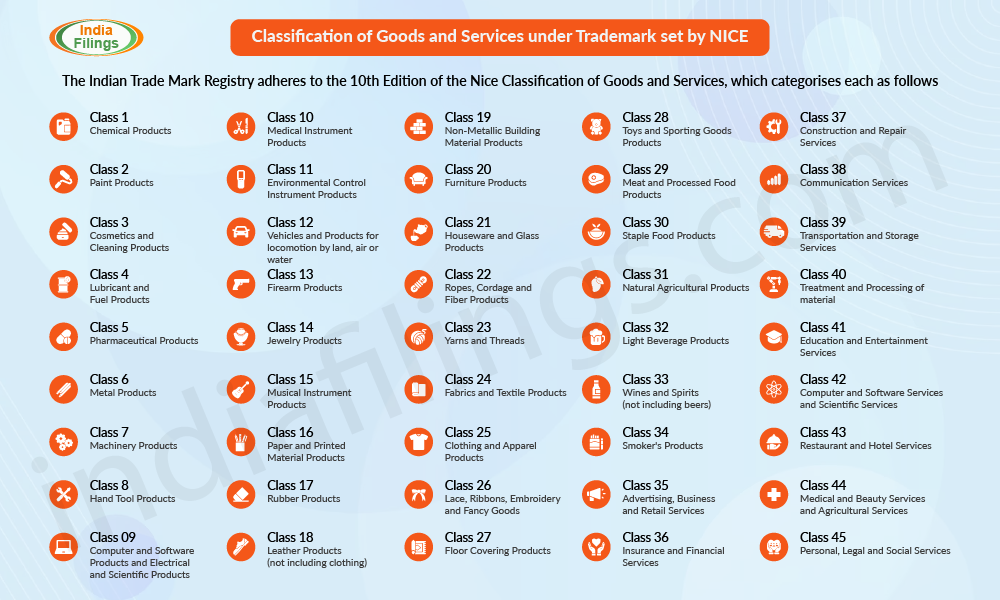Trademark Classification in India

Trademark Classification in India
Trademarks are essential assets for businesses as they represent a company’s identity, products, and services in the marketplace. In India, trademarks are classified to streamline registration and protect intellectual property rights. Understanding trademark classification is crucial for businesses registering their trademarks in India. In this article, we will delve into the intricacies of trademark classification in India, its significance, and how it impacts businesses.
IndiaFilings provides an online trademark class search tool. Start trademark class search now!
What is a Trademark?
A trademark is a form of intellectual property that confers exclusive rights to the owner for using a word, symbol, logo, phrase, design, sound, or expression. This means that only some individuals, entities, or organizations in the public domain can utilize the trademark with obtaining permission from the owner. Unauthorized use of the trademark can result in legal consequences. A trademark serves the crucial function of distinguishing a company’s products from those of others.
Why Trademarks Important for Businesses
Trademarks are essential for businesses because they:
- Stand Out: A trademark makes your business unique and helps customers easily recognize you.
- Boost Recognition: It helps people remember your brand, which builds trust and loyalty.
- Legal Protection: Trademarks stop others from using similar names or logos, safeguarding your brand.
- Online Presence: They’re vital in the digital age, making it easier to promote your business online.
- Fuel Growth: A strong brand with a trademark attracts customers, leading to business growth.
- Valuable Assets: Over time, trademarks become valuable assets that can be used for financing or sold.
In simple terms, trademarks are crucial for businesses as they set you apart, protect your brand, and drive growth.
What is Trademark classification?
Trademark classification is a systematic method of organising and categorising goods and services into specific classes. This classification system serves the crucial purpose of differentiating between various types of products and services, simplifying registering and protecting trademarks. This system adheres to the internationally recognized Nice Classification in India, as in many other countries.
Nice Classification
The Nice Classification structure divides goods and services into 45 classes. The first 34 classes are dedicated to goods, while the remaining 11 encompass services. Each class represents a unique category of goods or services, making it easier for trademark examiners to assess whether a proposed trademark conflict with existing ones. This organized classification system is instrumental in maintaining clarity and efficiency in trademark registration and protection.
Importance of Trademark Classification
A trademark serves as a vital asset for businesses due to several key reasons:
- Clear Identification: Trademark classification ensures businesses can precisely define the products or services they wish to safeguard. This clarity is crucial in avoiding disputes with similar trademarks.
- Legal Protection: Registering a trademark in the correct class grants legal protection and exclusive usage rights for that specific category of goods or services. This protection helps businesses defend their brand identity and reputation.
- Market Expansion: Proper classification allows businesses to expand their trademark coverage to include additional products or services within the same class in the future. This flexibility supports business growth and adaptation to changing market demands.
Basis of Trademark Classification
Specific criteria determine the basis of the classification of trademark classes for goods and services:
Trademark Class for Goods:
- Purpose and Function: Finished products are classified based on their intended purpose and function, particularly if they do not belong to any other class.
- Multipurpose Products: Products with multiple functions may fall into several classes corresponding to their different functions. If these functions are not covered in other classes, the classification may be based on factors such as the mode of transport or the primary raw materials used.
- Raw Materials or Semi-Finished Products: Raw or semi-finished products are classified according to the materials from which they are primarily made. In cases where a product is composed of multiple materials, it is classified based on the material that predominates in its composition.
Trademark Class for Services:
- Branches of Activity: Services are classified based on the branches of activity, as indicated in the headings and explanatory notes associated with each class. These headings guide the specific type of service in each class.
- Rental Services: Rental services are typically categorized within the same class, regardless of the nature of the items being rented.
- Advice or Consultation Services: Services related to advice, consultation, or information are classified according to the subject matter of the advice or consultation provided. This ensures that services are categorized based on their specific area of expertise or focus.
What are the Different Trademark Classes?
There are a total of 45 classes of trademarks, wherein 1-34 classes belong to products and 35-45 classes belong to services.

Consequences of Incorrect Classification in Trademark Registration
Properly classifying goods and services is of utmost importance in trademark registration. It ensures that the exact nature of the goods or services associated with a trademark is accurately identified. For instance, if a trademark is intended for use in the “manufacture of shirts and pants,” it should be filed in Class 25. Conversely, if the trademark pertains to the “sale of shirts and pants,” it falls under Class 35, which covers Retail Stores and Wholesale outlets.
Filing a trademark application in the wrong class can have significant consequences. It may lead to the trademark owner forfeiting their rights to enforce the trademark in cases of infringement. Therefore, precise classification is essential to protect and preserve the integrity of trademark rights, ensuring that they are correctly aligned with the specific goods or services they represent.
Trademark Class Finder
Our Trademark Class Finder Tool is designed to assist you in determining the appropriate class for registering a trademark for a specific product or service. Additionally, it allows you to verify whether another entity has already registered the intended trademark or name with the Trade Mark Registry. This tool simplifies the process of classifying and checking the availability of trademarks, ensuring a smoother registration process.
Start trademark class search now!Procedure for Trademark Classification and Registration
In India, trademark classification adheres to the Trademark Classification system. To successfully register a trademark, you must follow these essential steps:
- Determine the Class: Begin by identifying the class or classes that align with your goods or services. Each class encompasses a list of acceptable items, so choose the one that best suits your offerings.
- Search Existing Trademarks: Conduct a thorough trademark search to verify the uniqueness of your proposed trademark. Ensure it has not already been registered in the same class.
- File the Application: Prepare and submit a trademark application to the Indian Intellectual Property Office (IPO). Clearly specify the class or classes to which your trademark applies.
- Examination and Registration: The IPO will scrutinize your application for compliance with trademark laws and assess whether it conflicts with existing trademarks in the same class.
- Publication and Opposition: If your application successfully passes the examination, it will be published in the trademark journal. During this phase, others can oppose your trademark registration if they believe it infringes upon their rights.
- Trademark Registration: Without objections or oppositions, your trademark will be registered within the relevant class or classes.
Know more about Expedited Trademark Registration
Conclusion
Trademark classification is a crucial component of trademark registration in India. It ensures effective brand protection and prevents market confusion. Businesses can successfully navigate the trademark registration process by understanding the Nice Classification system and adhering to the proper procedures. Seeking legal guidance during trademark registration is advisable to ensure compliance with Indian trademark laws and enhance the protection of your intellectual property.
IndiaFilings: Your Trusted Partner in Trademark Registration and Classification
IndiaFilings plays a crucial role in simplifying India’s trademark registration and classification process. With our experienced professionals, IndiaFilings assists businesses in correctly identifying the appropriate class for their goods or services, ensuring accurate trademark classification. Additionally, we offer a tool for trademark classification and trademark search.
Get started today and protect your intellectual property with IndiaFilings! Register Now!


